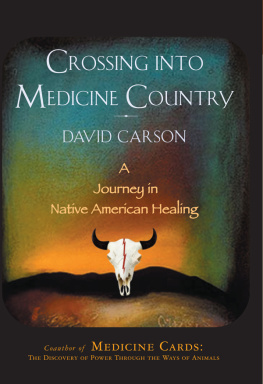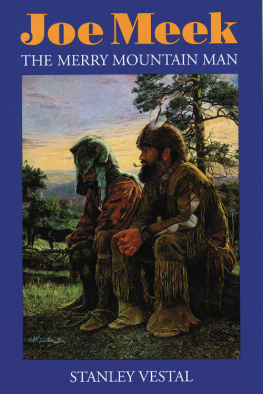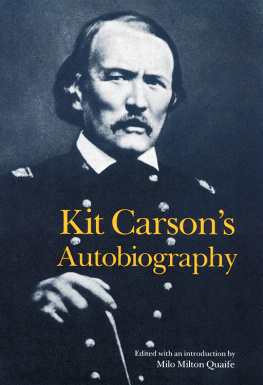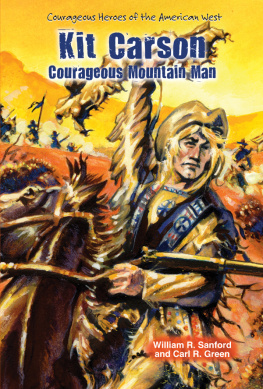The publisher does not have any control over and does not assume any responsibility for author or third-party websites or their content.
Kit Carson
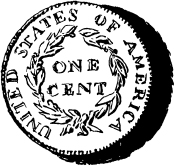
1
A Boy Worth One Cent
It has been said that great emergencies produce great men. It might almost seem that in 1809 destiny was preparing for the great crisis which the United States would face within the next generation. In that year two boys were born in the most humble of circumstances. Though they never met, these two boys, both of whom were born in a slavery state, were to be of tremendous importance in developing and holding the Union together. One of them would be a key figure in the expanding and securing of its frontier, and the other would be the rough-hewn genius who would successfully guide it through its most perilous years.
Abraham Lincoln was born in Hardin County, Kentucky, on February 12th, and Christopher Carson in Madison County the following Christmas. Both boys were the sons of ignorant, neer-do-well, frontiersman fathers and uneducated, overworked, but highly religious mothers. Always poverty-stricken and dissatisfied with their surroundings, these two fathers kept moving their large families farther and farther into the unsettled wilderness of the West. Their only ambition for their sons was that they might grow up to be strong, fearless, independent pioneers like themselves. As boys, both Abe and Kit were disappointments to their fathers.
It often happens that the thing we want most is the one which seems most impossible for us to have. This was true of both Abe Lincoln and Kit Carson. Abe was tall and extremely strong, but he was not interested in being a frontiersman. From early boyhood, his interest was in books and book learning. But there was little possibility of gaining an education on the American frontier. Kit had no interest in books or book learning. From the time he could walk, he wanted to be a giant frontiersman like his older brothers, but he was the runt of all the fourteen Carson children.
It would seem hard to find two boys so entirely different. But they were alike in many ways although Abe Lincoln attained a greatness far beyond that reached by Kit Carson. Each lost one of his parents in his early boyhood, and was raised in the home of a stepparent. Neither boy was outstanding as a child; both were inclined to be lazy in their early teens; and each was slow to develop his full powers. But, from early manhood, both gained the respect of those who knew them, because of the same high qualities of charactersteadfastness of purpose, absolute honesty, truthfulness, cool judgment in the face of seeming disaster, and an unshakable faith in God.
The Boones and the Carsons had been frontier neighbors for two generations. Not long before Kit was born, Daniel Boone had moved his family from Kentucky into the wilds of Missouri. When Kit was a year old, his father loaded his few sticks of furniture, his wife, and younger children into an ox cart, and headed west on the Boone Trail. He followed the trail to its end and built a rough log cabin near the banks of the Missouri Riverthe farthest west of any American settlement. A few other cabins were scattered there by the great river, and the settlement was called Franklin.
The year 1822 had a great effect upon Franklin and upon the life of Kit Carson. In that year Mexico won her independence from Spain, and General Ashley organized and took into the Rockies the first American expedition of beaver trappers.
By the Louisiana Purchase, made in 1803, the United States had bought from France all the land lying between the Mississippi River and the Continental Divide in the Rocky Mountains. The southern boundary was considered to be the Rio Grande, but this was not clearly set forth in the treaty. When Spain disputed Frances right to sell what is now Texas, New Mexico, and parts of Colorado and western Kansas, the United States had given up its claim to that territory. It was called New Mexico, and Santa Fe was its capital.
Eight hundred miles west of Franklin, where the southeast fringe of the Rockies reaches out into the plains and deserts, was the town of Santa Fe. It had been founded by the Spanish padres in 1605 and was built as the central mission in the midst of the centuries-old Pueblo Indian villages along the Rio Grande.
Before the Mexican revolution, Spain had permitted no foreign goods to be brought into her territory. Though the New Mexicans despised the gringos, they clamored for American merchandise. After winning their independence from Spain, they were willing to pay very high prices for it. By paying tribute of $500 a wagonload to the New Mexican governor, American merchants were permitted to bring caravans of goods into Santa Fe. The profits were enormous. Most of these goods were sent by boat up the Missouri River to Franklin. There the merchandise was loaded onto great eight-mule prairie schooners, and the caravans rolled west over the newly blazed Santa Fe Trail.
In 1800 Beau Brummel had popularized the beaver hat in England. By 1822 the rivers of England and the eastern United States had been trapped clear of beaver, but in the unknown streams of the Rocky Mountains they abounded. Prime beaver pelts were bringing six dollars apiece, and General Ashley was to become fabulously wealthy from his trapping expeditions.
Beaver pelts were in prime condition only from October to May. From mid-December till the first of April the beaver were safe in their lodges which were frozen as hard as stone. The mountains were wild and unmapped; Indians were always on the warpath against the white men who were taking their game; and the winters were severe. Only the hardiest and strongest men could survive as trappers.
Every one of the hundred frontiersmen Ashley took on his expedition of 1822 prided himself on his size, strength and reckless courage. And they were all in their early twenties. Among them were Jedediah Smith, Jim Bridger, William Sublette and Thomas Fitzpatrick. Along with Old Bill Williams, Jim Beckwourth and Joe Walker, they became famous as the greatest of the mountain men. Following General Ashleys success, other trapping expeditions were made up, and many frontiersmen went to the mountains in pairs or small parties. Among them were the two oldest Carson boys, William and Big Mose, both giants of men.




